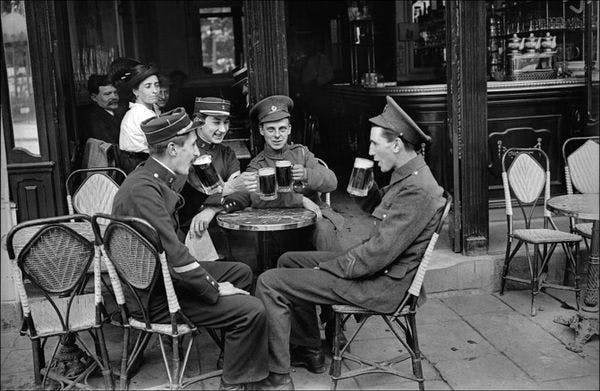Drugs, alcohol, and the First World War
By Virginia Berridge
The plethora of comment and reflection on the First World War has overlooked the importance of that war for drug and alcohol control. Yet this war was crucial in the establishment of a system of international control for drugs that still endures today. It instituted models of control for alcohol that also had a lengthy life. In 2014, the First World War is still a potent presence so far as drugs and alcohol are concerned.
International drug control had been discussed before the war, but a global system was unlikely. The major initiative had come from the Americans in the early 1900s, driven by twin motives of moral regulation and strategic advantage in the Far East. The Americans believed that “civilising” and converting the Chinese would come through the ending of their opium consumption. Missionaries and the US State Department had trained their sights on the Indo-Chinese opium trade, a trade which civil servants in the British Foreign Office were already bringing to a close. The Shanghai Convention of 1909 retained a Far Eastern focus, but afterwards the compass of potential control widened. There was genuine concern in the British Foreign Office about morphine and cocaine smuggling in southeast Asia and this topic was taken up by the Americans as an important part of the international control agenda.
The Hague Convention of 1912 was the product of this expanded geographical concern. The decision at the Hague that opium, morphine, and cocaine and their use should be confined to “legitimate medical purposes” was central to future international drug control. Earlier enquiries, such as the Indian Royal Commission on Opium of 1895, had defended medical and non-medical use, and indeed had taken the view that it was difficult to distinguish one type of use from the other. But there were further complications about extending control. The German Government refused to adhere to the Convention because it might be only partially applied and therefore damage the German cocaine industry; it insisted that all 34 participating powers had to ratify the Hague Convention before it could come into force. The convention thus had an “all or nothing” aspect that had not been initially intended. As the British Delegates wrote in their Report, “It [the convention] has, for the first time, laid down as a principle of international morality that the various countries concerned cannot stand alone in these measures.”
The German proviso was a delaying tactic and so only those countries committed to further controls went ahead before the outbreak of war. The USA was one, keen to take a prohibitionist stance. The US Harrison Act of 1914, a revenue measure, aimed to restrict access to drugs and to “stamp out” addiction. Other countries were less keen and by the outbreak of the First World War, there had been only eight ratifications. In the UK, rather desultory discussions before the war envisaged simply an extension of existing pharmacy controls and possibly some further restrictions on the dispensing of doctors' prescriptions.
The war changed the situation. In the UK, it brought the Home Office—in 2014 still the lead department for drug policy—into a central role and also more stringent restriction onto the agenda. Two issues caused concern. Smuggling of drugs showed that controls were indeed interdependent at the international level. The UK was the world's major manufacturer of morphine and the exported drug was being diverted into China via Japan. The Home Office introduced a system of import/export certification designed to ensure that all shipments out of the country had a legitimate destination. Morphine was the main smuggled drug but the use of cocaine also seemed to be expanding in some of the combatant countries. It was feared that army efficiency was at risk.
Click here to read the full article.
Keep up-to-date with drug policy developments by subscribing to the IDPC Monthly Alert.
